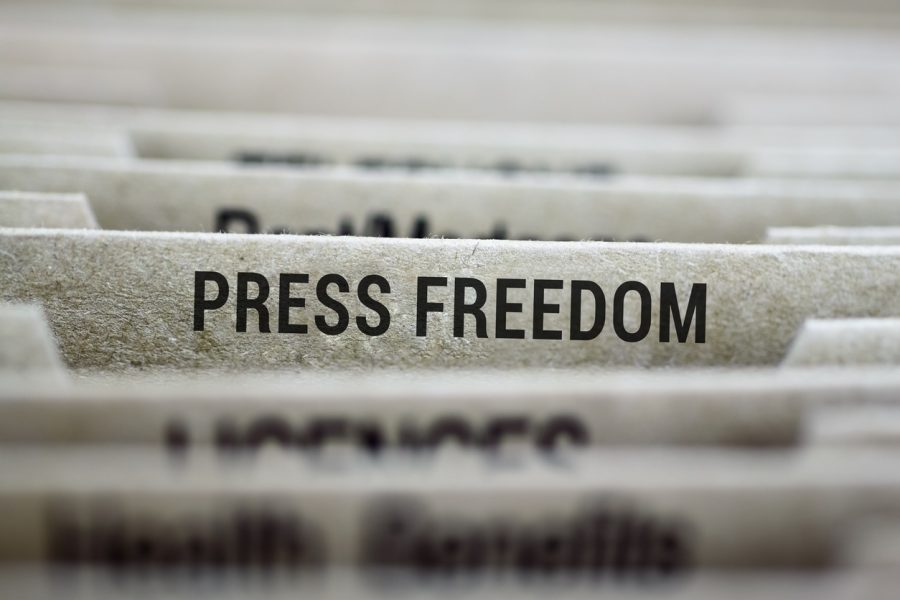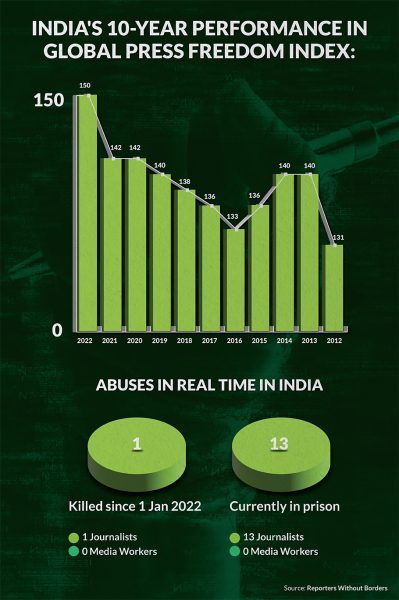
India among world’s 'most dangerous nations for media': Press Freedom Index
"Journalists in India are exposed to all kinds of physical violence including police violence, ambushes by political activists, and deadly reprisals by criminal groups or corrupt local officials,” the report said

India’s press freedom ranking has fallen from 142 out of 180 countries in 2021 to 150 in 2022 and “is one of the world’s most dangerous countries for the media”, according to the 2022 World Press Freedom Index published by Reporters Without Borders (RSF) on Tuesday (May 3).
Since January 1, 2022, one journalist was killed in India, and 13 are currently in prison, as per the report.

According to RSF, press freedom is defined “as the ability of journalists as individuals and collectives to select, produce, and disseminate news in the public interest independent of political, economic, legal, and social interference and in the absence of threats to their physical and mental safety”.
The 20th World Press Freedom Index’s rankings are based on a score ranging from 0 to 100 that is assigned to each country or territory, with 100 being the best possible score (the highest possible level of press freedom) and 0 the worst.
India is a ‘difficult’ place for journalists
According to the report, this score is calculated on the basis of two components, “a quantitative tally of abuses against journalists in connection with their work, and against media outlets; a qualitative analysis of the situation in each country or territory based on the responses of press freedom specialists (including journalists, researchers, academics and human rights defenders) to an RSF questionnaire available in 23 languages.”
India’s score is 41.00 (150th rank), down from 53.44 in 2021 when it was ranked 142. As per the score, India is in the “difficult” category as it falls in the 40-55 points bracket. A score of 85-100 is “good” while 70-85 is “satisfactory” and 55-70 is “problematic”. If the score is between 0 and 40, then it is “very serious”.
Norway is ranked number one in the World Press Freedom Index followed by Denmark, Sweden, Estonia and Finland. The US is ranked 42.
“The world’s 10 worst countries for press freedom include Myanmar (176th), where the February 2021 coup d’état set press freedom back by 10 years, as well as China (175th), Turkmenistan (177th), Iran (178th), Eritrea (179th) and North Korea (180th).
“Confrontation between ‘blocs’ is growing, as seen between nationalist Narendra Modi’s India (150th) and Pakistan (157th). The lack of press freedom in the Middle East continues to impact the conflict between Israel (86th), Palestine (170th) and the Arab states,” the report said.
“With an average of three or four journalists killed in connection with their work every year, India is one of the world’s most dangerous countries for the media. Journalists are exposed to all kinds of physical violence including police violence, ambushes by political activists, and deadly reprisals by criminal groups or corrupt local officials,” the report said.
‘Stop targeting journalists’
On World Press Freedom Day (May 3), RSF and nine other human rights organisations asked the Indian authorities “to stop targeting journalists and online critics for their work. More specifically, they should stop prosecuting them under counterterrorism and sedition laws”.
In the report, RSF said, “The violence against journalists, the politically partisan media and the concentration of media ownership all demonstrate that press freedom is in crisis in ‘the world’s largest democracy’, ruled since 2014 by Prime Minister Narendra Modi, the leader of the Bharatiya Janata Party (BJP) and the embodiment of the Hindu nationalist right.”
“Originally a product of the anti-colonial movement, the Indian press used to be seen as fairly progressive but things changed radically in the mid-2010s, when Narendra Modi became prime minister and engineered a spectacular rapprochement between his party, the BJP, and the big families dominating the media,” it added.
‘Harassment and attack campaigns’
The report said Indian journalists who are too critical of the Modi government are “subjected to all-out harassment”.
“Very early on, Modi took a critical stance vis-à-vis journalists, seeing them as “intermediaries” polluting the direct relationship between himself and his supporters. Indian journalists who are too critical of the government are subjected to all-out harassment and attack campaigns by Modi devotees known as bhakts,” it said.
At the height of the Covid-19 crisis, the report said, “some TV hosts blamed the Muslim minority for the spread of the virus”.
On the safety aspect, it said, “Supporters of Hindutva, the ideology that spawned the Hindu far right, wage all-out online attacks on any views that conflict with their thinking. Terrifying coordinated campaigns of hatred and calls for murder are conducted on social media, campaigns that are often even more violent when they target women journalists, whose personal data may be posted online as an additional incitement to violence. The situation is also still very worrisome in Kashmir, where reporters are often harassed by police and paramilitaries, with some being subjected to so-called ‘provisional’ detention for several years.”


